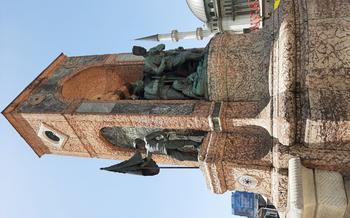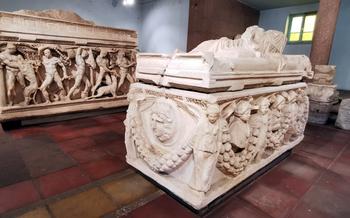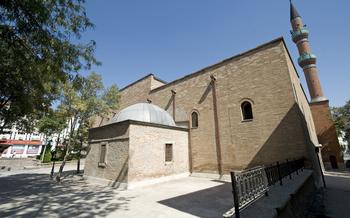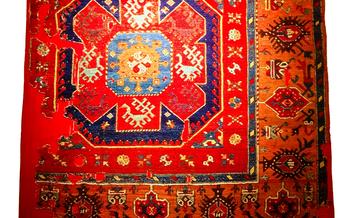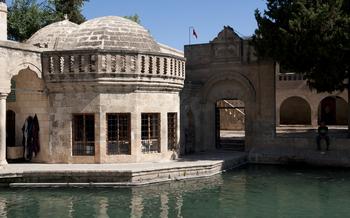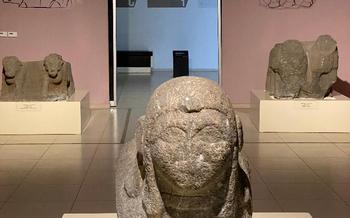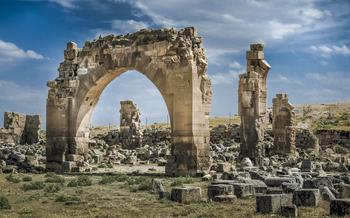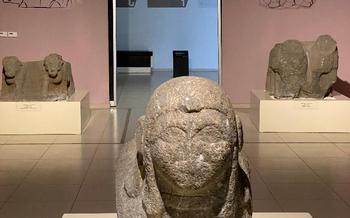
Çoban Müzesi (Shepherd's Museum)
- A Journey into the Heart of Turkish Nomadic Culture
- Location and Accessibility
- A Glimpse into the Museum's History
- Architectural Marvels
- Immersive Exhibits
- Textile Treasures
- Tools and Craftsmanship
- Storytelling and Oral Traditions
- Educational Programs
- Community Engagement
- Cultural Events and Festivals
- Hands-on Activities: Embracing the Nomadic Lifestyle
- The Nomadic Lifestyle: Embracing Change and Resilience
- Reflections on Modern Life
- Insider Tip: Guided Tours and Local Insights
A Journey into the Heart of Turkish Nomadic Culture
In the captivating city of Şanlıurfa, Turkey, lies the Çoban Müzesi, a treasure trove dedicated to preserving and celebrating the rich history and traditions of Turkey's nomadic tribes. Step into this enchanting museum, and you will embark on a captivating journey into the heart of a culture that has shaped the tapestry of Anatolian life for centuries. Discover the significance of the Çoban Müzesi in safeguarding this unique heritage, as it showcases the intriguing lifestyle, customs, challenges, and triumphs of the nomadic shepherds who once roamed these lands. Prepare to be inspired by their resilience, adaptability, and deep connection to the natural world as you delve into the fascinating world of Turkish nomadic culture.
Location and Accessibility
Nestled amidst the vibrant city of Şanlıurfa in Turkey, the Çoban Müzesi stands as a testament to the rich nomadic heritage of the region. Reaching the museum is a breeze, whether you prefer the convenience of public transportation or the freedom of a private vehicle. For those arriving by air, Şanlıurfa Airport offers direct flights from major cities within Turkey and beyond. Once in Şanlıurfa, you can hop on a local bus or taxi to reach the museum, which is conveniently located in the city center.
To make the most of your visit, plan your trip during the spring or fall, when the weather is at its most pleasant. This allows you to comfortably explore the museum's outdoor exhibits and immerse yourself in the surrounding natural beauty. If you're seeking a truly immersive experience, time your visit to coincide with one of Şanlıurfa's many cultural festivals or celebrations. These events provide a vibrant showcase of traditional music, dance, and cuisine, offering a glimpse into the rich cultural tapestry of the region.
A Glimpse into the Museum's History
The Çoban Müzesi is not just a museum; it is a testament to the dedication and passion of individuals who recognized the importance of preserving Turkey's nomadic heritage. Founded in 1991, the museum was the brainchild of a group of passionate individuals, including anthropologists, historians, and local community members.
Driven by a shared vision to protect and promote nomadic culture, they embarked on a journey to establish a museum that would serve as a sanctuary for the traditions and artifacts of the nomadic tribes. The choice of Şanlıurfa as the museum's location was strategic, as the city holds a rich history of nomadic settlements and cultural exchange.
With meticulous care and attention to detail, the museum's founders worked tirelessly to gather artifacts, conduct research, and document the stories of nomadic shepherds. Through their efforts, the Çoban Müzesi emerged as a beacon of cultural preservation, showcasing the unique way of life and traditions of Turkey's nomadic communities.
Today, the museum continues to play a vital role in educating visitors about nomadic culture and promoting cultural diversity. It stands as a testament to the power of collaboration, dedication, and the unwavering spirit of those who recognized the importance of safeguarding a rich and vibrant heritage.
Architectural Marvels
The Çoban Müzesi stands as a testament to the architectural ingenuity and creativity of the nomadic tribes. Its design seamlessly blends traditional elements with modern aesthetics, creating a visually stunning and immersive experience for visitors. As you explore the museum's various sections, each dedicated to a different aspect of nomadic culture, you'll marvel at the intricate details and craftsmanship that bring the exhibits to life.
The museum's architecture is a reflection of the nomadic lifestyle, with its fluid forms and movable structures echoing the transient nature of their existence. Discover the stories behind the unique architectural features, such as the domed roofs inspired by traditional tents or the use of natural materials that pay homage to the nomadic reliance on the environment.
From the grand entrance to the intimate courtyards, every corner of the Çoban Müzesi is a testament to the nomadic spirit. Admire the intricate carvings, colorful tiles, and hand-painted motifs that adorn the walls, each telling a tale of the rich cultural heritage of the nomadic tribes.
Immersive Exhibits
Within the Çoban Müzesi's walls, a captivating journey unfolds, bringing the vibrant world of nomadic culture to life. Immerse yourself in the traditional tents, where nomadic shepherds once sought shelter and community. Examine the clothing, tools, and everyday objects that defined their way of life. Each artifact tells a story of resilience, ingenuity, and the enduring spirit of the nomadic tribes.
Interactive displays invite you to engage with nomadic culture on a deeper level. Step into virtual reality experiences that transport you to the heart of nomadic communities, allowing you to witness their daily routines, challenges, and triumphs. Listen to personal stories and anecdotes that shed light on the unique perspectives and experiences of nomadic life. Through these immersive exhibits, the Çoban Müzesi offers a profound understanding of the rich heritage and traditions of Turkey's nomadic tribes.
Textile Treasures
The Çoban Müzesi houses an exceptional collection of nomadic textiles, renowned for their vibrant colors and intricate designs. These textiles are not merely decorative pieces; they hold profound cultural significance and reflect the nomadic tribes' rich heritage. Each textile tells a story, embodying the skills, artistry, and traditions of the people who created it.
Discover the symbolism and craftsmanship behind these beautiful creations. Learn about the techniques and materials used to create these unique textiles, such as wool, goat hair, and cotton. Admire the intricate patterns and motifs that reflect the rich cultural heritage of the nomadic tribes. These textiles showcase the nomads' deep connection to their environment, their beliefs, and their way of life.
Explore the museum's collection of kilims, woven rugs, and other textiles used for various purposes, from everyday use to special occasions. Each piece is a testament to the nomadic tribes' ingenuity and artistry. Immerse yourself in the vibrant colors and intricate designs, and gain a deeper appreciation for the cultural significance of these textile treasures.
Tools and Craftsmanship
Discover the ingenious tools and craftsmanship that sustained nomadic life at the Çoban Müzesi. Examine traditional weaving looms, cooking utensils, and other essential tools that allowed nomadic shepherds to thrive in their ever-changing environment. Learn about the skills and techniques passed down through generations, showcasing the artistry and functionality of these handcrafted items. Appreciate the intricate designs and craftsmanship that reflect the nomadic tribes' resourcefulness and adaptability. Immerse yourself in the ingenuity and practicality of nomadic tools, gaining a deeper understanding of their way of life and the challenges they faced.
Storytelling and Oral Traditions
Nomadic tribes have a rich tradition of storytelling and oral history that has played a vital role in preserving their cultural identity and values. The Çoban Müzesi showcases this tradition through captivating tales and legends that have been passed down through generations. Visitors can immerse themselves in these stories, listening to skilled storytellers bring to life the adventures, struggles, and triumphs of nomadic life.
Oral traditions serve as a powerful means of transmitting cultural knowledge, moral values, and historical events from one generation to the next. Through these stories, the nomads passed on their wisdom, experiences, and beliefs, ensuring the continuity of their cultural heritage.
The Çoban Müzesi recognizes the significance of these traditions and works to preserve and promote them. By sharing these stories with visitors, the museum helps to bridge generations and foster a deeper understanding of the nomadic way of life.
Educational Programs
The Çoban Müzesi is dedicated to promoting understanding and appreciation of nomadic culture through a variety of educational programs. These programs are designed to engage visitors of all ages and backgrounds, providing opportunities to learn about and immerse themselves in the nomadic way of life.
Workshops are a popular way to experience nomadic culture firsthand. Visitors can learn traditional skills such as weaving, cooking, and playing traditional games. These workshops provide a hands-on learning experience that allows participants to connect with the nomadic past in a meaningful way.
Lectures and demonstrations are another way to gain insights into nomadic culture. Experts in various fields, such as anthropology, history, and textiles, share their knowledge and research with visitors. These events provide an opportunity to learn about the challenges and triumphs of nomadic life, as well as the significance of nomadic traditions in a modern context.
The Çoban Müzesi also offers educational programs for students and researchers. These programs provide opportunities for students to engage in cultural studies and research projects, while researchers can access the museum's extensive collection of artifacts and resources. The museum's commitment to education helps to foster cross-cultural dialogue and promote cultural diversity.
Community Engagement
The Çoban Müzesi is deeply committed to community engagement, recognizing the importance of preserving traditional skills and livelihoods. The museum collaborates with local artisans, craftsmen, and storytellers to showcase their work and share their knowledge with visitors. Through these partnerships, the museum supports the preservation of traditional skills and helps to ensure that these cultural practices continue to thrive.
The Çoban Müzesi also actively promotes sustainable tourism practices that benefit the local community. The museum encourages visitors to engage with local businesses, such as restaurants, shops, and guesthouses, to support the local economy. By fostering a sense of community and promoting cultural understanding, the Çoban Müzesi contributes to the sustainable development of the region.
Cultural Events and Festivals
The Çoban Müzesi is not just a museum; it's a vibrant cultural hub that hosts a variety of events and festivals throughout the year. These events provide an immersive experience for visitors, allowing them to delve deeper into the rich traditions of nomadic culture.
One of the highlights is the annual "Nomadic Culture Festival," a grand celebration that showcases the diverse heritage of nomadic tribes. Immerse yourself in traditional music, dance, and culinary delights as you witness the vibrant performances and demonstrations. Learn about the significance of these events in celebrating nomadic heritage and fostering community spirit.
Don't miss the opportunity to participate in hands-on workshops and cultural demonstrations. Try your hand at weaving, cooking traditional dishes, or playing traditional games. These interactive experiences allow you to connect with nomadic culture on a personal level and create lasting memories.
By attending these events, you'll gain a deeper understanding of the nomadic way of life and its enduring impact on Turkish culture. Check the museum's website or contact them directly for information on upcoming events and festivals.
Hands-on Activities: Embracing the Nomadic Lifestyle
The Çoban Müzesi offers a unique opportunity to engage in hands-on activities that allow visitors to experience the nomadic lifestyle firsthand. Participate in traditional weaving workshops, where you can learn the intricate techniques used to create beautiful textiles. Discover the secrets of nomadic cuisine by cooking traditional dishes using authentic recipes and ingredients. Immerse yourself in the vibrant culture by learning to play traditional games that have been passed down through generations.
These hands-on activities provide a deeper understanding of the skills and knowledge required for nomadic survival. Learn how to weave sturdy tents that can withstand harsh weather conditions, create warm and comfortable bedding using natural materials, and craft essential tools for everyday life. Experience the challenges and rewards of nomadic life as you engage in these interactive activities.
As you immerse yourself in these hands-on experiences, you will create lasting memories that will transport you back to the nomadic way of life. Embrace the spirit of adventure and discovery as you learn from the wisdom and resilience of the nomadic tribes.
The Nomadic Lifestyle: Embracing Change and Resilience
The Çoban Müzesi not only showcases the material culture of nomadic tribes but also delves into the essence of their lifestyle, revealing the challenges and rewards that shaped their existence. Nomadic life required adaptability and resilience, as people moved from place to place in search of pasture for their animals and sustenance for their families. They developed a deep understanding of the natural environment, relying on seasonal changes and patterns to guide their movements.
Nomadic societies were characterized by a strong sense of community and interconnectedness. Families and clans traveled together, sharing resources and responsibilities. Cooperation and mutual support were essential for survival in a harsh and unpredictable environment. The nomadic lifestyle fostered a sense of self-reliance and independence, as individuals learned to rely on their own skills and knowledge to navigate the challenges of their surroundings.
Despite the hardships they faced, nomadic people also experienced a sense of freedom and connection to the land. They lived in harmony with nature, adapting to its rhythms and embracing the beauty of their ever-changing surroundings. Their way of life taught them the importance of flexibility and the ability to let go of material possessions in order to embrace the unknown.
In a world that is increasingly fast-paced and interconnected, the nomadic lifestyle offers valuable lessons in adaptability, resilience, and community spirit. By exploring the Çoban Müzesi and learning about the nomadic culture, visitors can gain a deeper appreciation for the diversity of human experiences and the importance of preserving cultural traditions in a rapidly changing world.
Reflections on Modern Life
The Çoban Müzesi offers a unique opportunity to reflect on the relevance of nomadic culture to modern society. In a world that is increasingly fast-paced and interconnected, the nomadic way of life can teach us valuable lessons about adaptability, resilience, and community spirit.
The nomadic lifestyle required individuals to be adaptable and flexible in the face of changing circumstances. They had to be able to quickly adapt to new environments, learn new skills, and find new sources of food and water. This adaptability is a valuable trait in today's rapidly changing world, where we are constantly faced with new challenges and opportunities.
The nomadic lifestyle also required individuals to be resilient and resourceful. They had to be able to overcome challenges and setbacks, and find creative solutions to problems. This resilience is essential for success in any endeavor, whether it be personal or professional.
Finally, the nomadic lifestyle was characterized by a strong sense of community and interconnectedness. Nomadic tribes relied on each other for support and cooperation, and they shared a common culture and traditions. This sense of community is often lacking in modern society, where people are often isolated and disconnected from their neighbors.
The Çoban Müzesi helps us to understand the value of nomadic culture and its relevance to modern society. By learning about the nomadic way of life, we can gain insights that can help us to live more adaptable, resilient, and fulfilling lives.
Insider Tip: Guided Tours and Local Insights
Enrich your experience at the Çoban Müzesi by taking advantage of the guided tours offered by the museum. Knowledgeable guides will lead you through the exhibits, providing insightful commentary and anecdotes that bring the museum's collection to life. Discover hidden gems and lesser-known stories that reveal the depth and richness of nomadic culture.
With a guided tour, you'll gain a deeper understanding of the challenges, triumphs, and traditions of nomadic life. Your guide will point out intricate details and explain the significance of artifacts, textiles, and tools. Immerse yourself in the stories of the nomadic shepherds and their families, and learn about their unique way of life.
To make the most of your visit, ask your guide for recommendations on other places to visit in Şanlıurfa that offer a glimpse into nomadic culture. They can suggest local markets, restaurants, or festivals where you can experience the vibrant traditions of the region firsthand. Embrace the opportunity to interact with the local community and gain a deeper appreciation for their heritage.
Whether you're a history buff, a culture enthusiast, or simply curious about the nomadic lifestyle, a guided tour of the Çoban Müzesi is an unforgettable experience that will leave you with a lasting impression.
